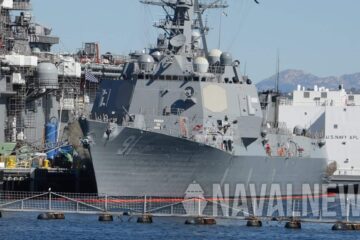Weighing in at 588 tons, the 56-foot-long, 33-foot-wide island will sit atop the flight deck and serve as the command center for flight deck operations aboard the second aircraft carrier in the Gerald R. Ford class. It will house the navigation bridge, primary flight control, radar and other systems.
The landing of the island on an aircraft carrier is analogous to “stepping the mast” aboard a sailing ship or the topping out of a skyscraper.
“With the island landing, John F. Kennedy takes on that distinctive and unmistakable profile of an aircraft carrier,” said Rear Adm. Brian Antonio, program executive officer for Aircraft Carriers. “It symbolizes nearing the end of structural work and the start of bringing the ship to life, transitioning steel and cable to a living ship and crew.”
The May 29th ceremony date marks the 102nd birthday of the late President Kennedy, and is also the date that the carrier’s name was officially announced in 2011. Caroline Kennedy, former U.S. ambassador to Japan, is the Ship’s sponsor for both aircraft carriers named after her father. The first (CV 67), was a conventionally-powered carrier that served from 1968 to 2007.
While USS Gerald R. Ford (CVN 78) was the heaviest and most complete carrier at launch, Kennedy is projected to be even heavier before she is floated off the blocks for her next phase of construction.
“Improvements in build strategy and material procurement are enabling John F. Kennedy to be constructed with approximately 18% fewer production hours than those needed for CVN 78,” said Capt. Phil Malone, program manager for the CVN 79/80/81 program office (PMS 379).





